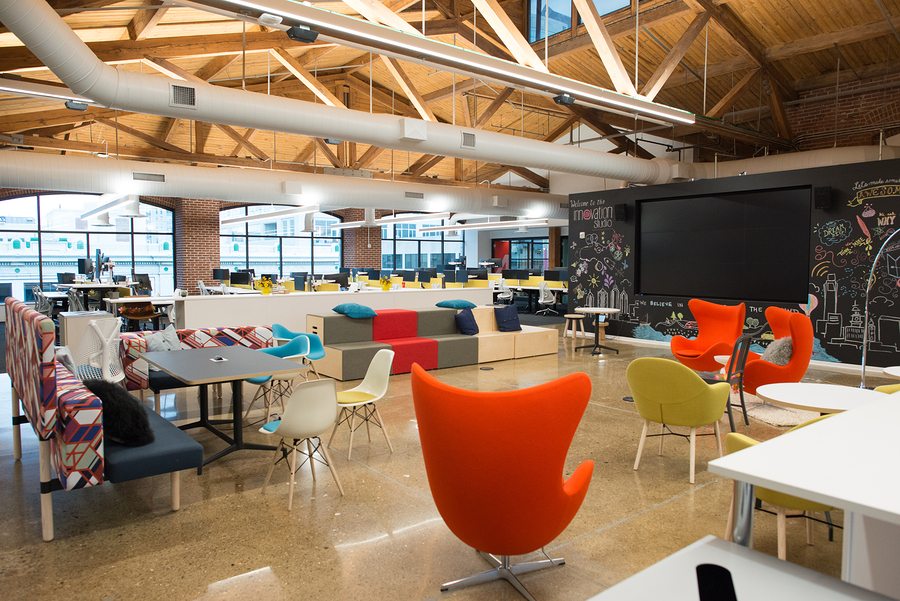Workplace Redesign: How a Communal Office Space Improves Engagement
January 12, 2018

Most office workers say innovation isn’t reflected in the design of their current workplace, according to a 2017 Capital One survey. Are your employees among them?
The workplace has undergone significant change in recent years. Demographic, economic and cultural shifts have converged, giving rise to the communal office space. They’re open and flexible, letting people meet easily and collaborate. These spaces also show a focus on culture, agility and engagement, and away from tasks and products.
Companies want to be competitive and drive productivity and creativity. Innovators are tearing down cubicle walls, literally.
What Employees Want
Many of today’s employees desire a flexible workplace design and attractive design elements. Capital One’s survey of office professionals across five major markets — New York, Chicago, Dallas, San Francisco and Washington — takes a closer look at the influence design has on employees.
The survey found that 82 percent of office professionals believe companies can’t encourage innovation unless their workplace itself is innovative. Other findings include:
- 85 percent say flexible workplace design is essential
- 82 percent say they have their best ideas working in flexible space options
- The most desired design elements included natural light, artwork and easily-reconfigured furniture and spaces.
Millennials are driving much of the change toward communal office spaces. The Brookings Institute, a nonprofit public policy organization, found that the ideal workplace for millennials includes spaces that are social, flexible, comfortable, open and spacious, as well as technology-centered and environmentally conscious. Older generations tend to view design as a means to connect to newer generations of workers.
In other words? These spaces are creating the right kind of environment to bring multi-generational groups together. This shift is significant because the majority of your costs are people — and the majority of employees are disengaged.
Only 33 percent of employees in the U.S. are engaged — involved in, enthusiastic about and committed to their work — according to a 2016 Gallup report. This number is the highest in Gallup’s 15-plus years of tracking employee engagement, but it’s not a cause for celebration.
The more disconnected employees feel, the higher their readiness to job hop. While 37 percent of engaged employees are looking for jobs or watching for opportunities, higher numbers of not-engaged and actively disengaged employees are doing the same (56 percent and 73 percent, respectively).
A redesigned workspace alone may not solve your company’s engagement challenge, but it can impact culture — and culture is a catalyst for change.
Case in Point: The RAND Corp.
The RAND Corp., a research-oriented nonprofit thinktank, put this trend to the test. RAND was once at the forefront of collaborative office design, with an environment that created chance encounters between people from different divisions. But its North American offices had come to resemble a more typical U.S. workplace: lots of cubicles, and little face-to-face interaction.
In 2016, RAND decided to rethink one wing of its Washington office to create community while honoring privacy. The new work environment has various spaces to meet employees’ needs, and no one owns an office. According to RAND, the space “has the feel of a slightly futuristic library.”
It offers a quiet, open area of workstations with glass-walled offices along the sides, and lower barriers so people can see each other. If an employee needs a quiet space for meetings, or is immersed in a project and needs to avoid distractions, she can reserve a private office.
RAND partnered with a team of researchers from Cornell University to evaluate the success of the pilot workspace, and the results were positive. Around 90 percent of the workers said the new configuration supported individual, high-concentration work at least as well as their old workspaces had. The same number said it provided better (or much better) opportunities for collaboration. More than two-thirds of the people working there said they had more unplanned interactions with their co-workers than they had before.
Only two out of 63 employees requested a transfer back to their old offices when the trial period was over. Given the pilot’s success, RAND planned to expand its “future workplace” to a newly-acquired floor.
Give Employees a Voice
Before you start tearing down cubicles and removing office doors, first poll your employees. This will help you understand their specific needs and wants, so you can increase engagement. Giving your employees a voice in the redesign also will strengthen loyalty and improve workplace happiness.
Connecting Elements, which distributes and markets office furnishings, has outlined a list of questions to ask employees as the first step in your redesign:
- Where do you spend most of your time working?
- Is your work style more collaborative or independent?
- How helpful is it to have easy access to your team or other departments?
- What’s the biggest hassle in your job?
- Are you happiest in a space buzzing with activity or in a quiet area?
- If you could redesign the office yourself, what’s one thing you would do differently?
Summary
Transforming a work environment into a communal office space may not be an ideal fit for everyone.
But, as research has demonstrated, it’s appealing to the masses and beneficial to an organization overall.
You can begin transforming your company’s culture and improving its economic health with an innovative, communal office space that encourages collaboration and engagement while honoring privacy.
- More content on workplace management: How to Handle Employee Conflicts
Recent Articles
Stay informed with Aprio.
Get industry news and leading insights delivered straight to your inbox.
